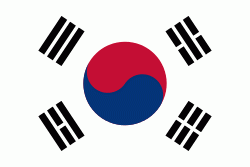Jung District (Jung-gu)
Jung District (Jung-gu) is a gu, or district, covering the downtown area of Daegu, South Korea. It borders most of the other districts of Daegu, including Nam-gu to the south, Seo-gu to the west, Buk-gu to the north, and Dong-gu and Suseong-gu to the east. The northern border is formed by the Gyeongbu Line railroad, and the eastern border by the Sincheon stream.
Jung-gu is at the nexus of Daegu Subway Line 1 and Daegu Subway Line 2. Daegu Subway Line 3 will also pass through the district when it is completed.
Much of Jung-gu once lay within the old confines of Daegu Castle, which at one time comprised the entire town of Daegu. A small part of the castle wall is preserved in Dalseong Park. Many historical incidents in the history of Daegu took place in the district, including the recent Daegu subway fire and the February 28th movement calling for the end of the autocratic Rhee regime in 1960. The district was formally established in 1963, with the introduction of the gu system.
Jung-gu is at the nexus of Daegu Subway Line 1 and Daegu Subway Line 2. Daegu Subway Line 3 will also pass through the district when it is completed.
Much of Jung-gu once lay within the old confines of Daegu Castle, which at one time comprised the entire town of Daegu. A small part of the castle wall is preserved in Dalseong Park. Many historical incidents in the history of Daegu took place in the district, including the recent Daegu subway fire and the February 28th movement calling for the end of the autocratic Rhee regime in 1960. The district was formally established in 1963, with the introduction of the gu system.
Map - Jung District (Jung-gu)
Map
Country - South_Korea
 |
 |
| Flag of South Korea | |
The Korean Peninsula was inhabited as early as the Lower Paleolithic period. Its first kingdom was noted in Chinese records in the early 7th century BCE. Following the unification of the Three Kingdoms of Korea into Silla and Balhae in the late 7th century, Korea was ruled by the Goryeo dynasty (918–1392) and the Joseon dynasty (1392–1897). The succeeding Korean Empire (1897–1910) was annexed in 1910 into the Empire of Japan. Japanese rule ended following Japan's surrender in World War II, after which Korea was divided into two zones; a northern zone occupied by the Soviet Union and a southern zone occupied by the United States. After negotiations on reunification failed, the southern zone became the Republic of Korea in August 1948 while the northern zone became the communist Democratic People's Republic of Korea the following month.
Currency / Language
| ISO | Currency | Symbol | Significant figures |
|---|---|---|---|
| KRW | South Korean won | â‚© | 0 |
| ISO | Language |
|---|---|
| EN | English language |
| KO | Korean language |















